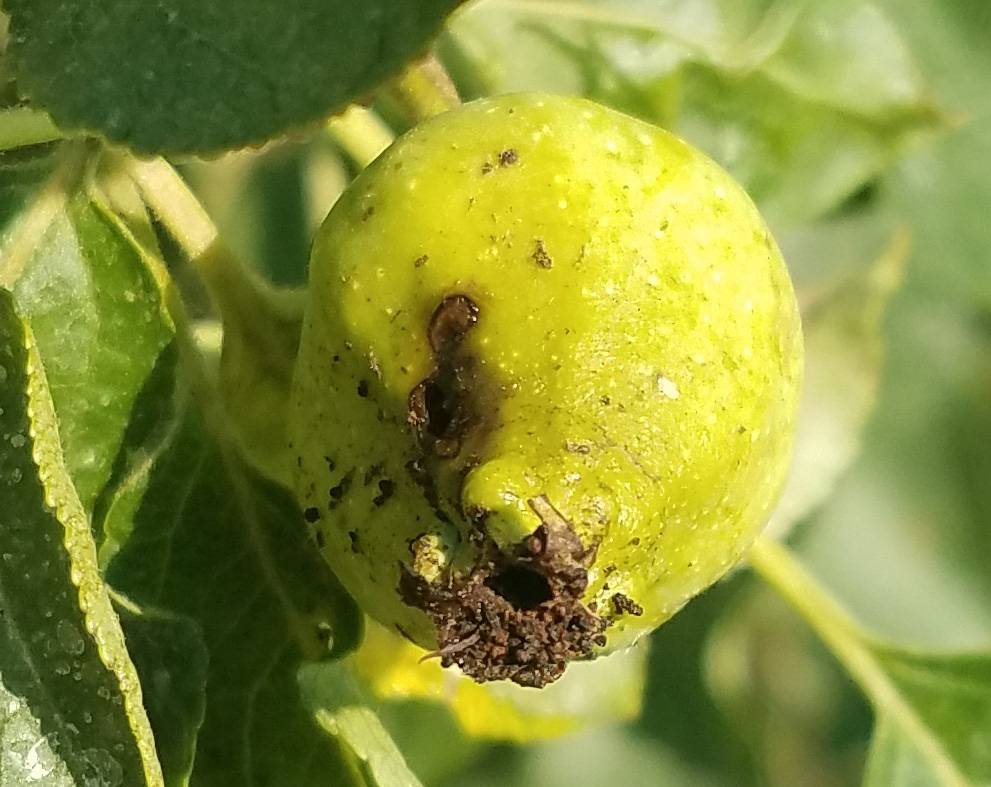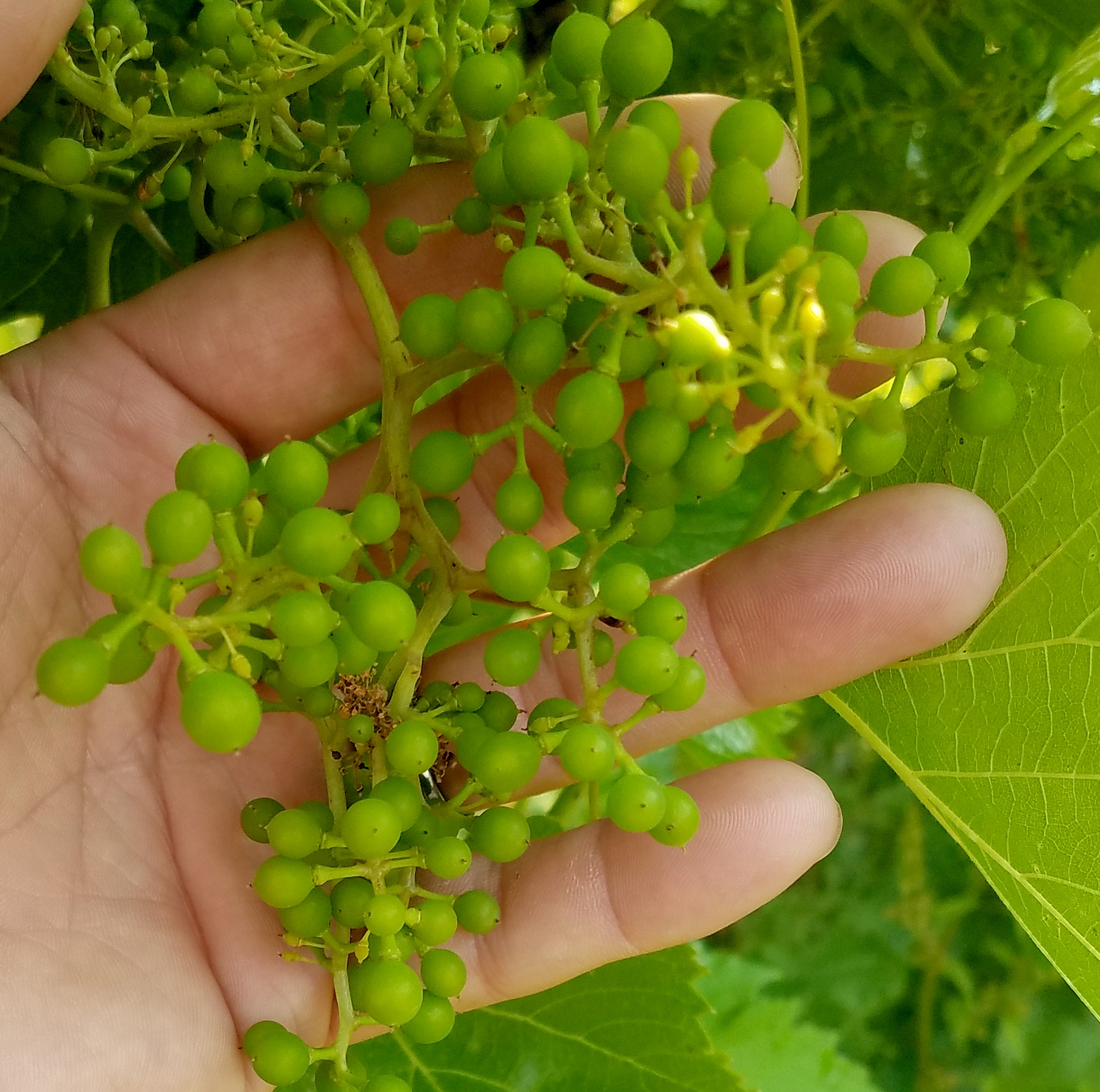Southwest Michigan fruit update – June 23, 2020
The warm, dry week has moved many fruits. Early color can be seen on cherries and many small fruits.

Weather
Last week was hot. Highs were in the 80s and low 90s. A cold front on Tuesday night, June 16, brought a quarter to a half inch of rain. Cooler temperatures are back for a few days. Expect highs in the 70s and lows near 60 for much of the week, climbing to the 80s by the weekend. Rain is expected over the weekend. With the warm week, we picked up a lot of growing degree days (GDD) last week: 206 GDD base 42 and 150 GDD base 50, respectively 29 and 21 per day.
|
Southwest Michigan GDD summary from March 1 - June 14, 2020 | |||
|---|---|---|---|
|
Station |
GDD 42 F |
GDD 45 F |
GDD 50 F |
|
Benton Harbor (SWMRC) |
1,316 |
1,106 |
803 |
|
Lawton (Lawton) |
1,315 |
1,102 |
795 |
|
Fennville (TNRC) |
1,183 |
980 |
690 |
|
Average for the SW region |
1,297 |
1,086 |
783 |
|
Average last week |
1,091 |
901 |
633 |
Tree fruit
Recent rains have helped to relieve water stress of fruit trees in the area. Codling moth, San Jose scale and obliquebanded leafroller flights are underway. The second flight of Oriental fruit moth is expected soon.
Peaches and nectarines are averaging 1.5 inches in diameter, with pits expected to start hardening next week. Estimated harvest dates for Red Haven in central Berrien County for 2020 is Aug. 4. Early season varieties such as PF-1 are expected to start to ripen in the first week of July. Both lesser and greater peach tree borer adult moths are being caught. Oriental fruit moth flagging of terminal growth is still relatively rare.
In cherries, sweet cherries are ripening and becoming attractive to spotted wing Drosophila. Tart cherries are straw to early red color, the typical stage for ethrel treatment in advance of mechanical harvest.
Brown rot has been seen in sweet cherries. Sweet cherries are always susceptible to brown rot. Brown rot management is important when warm temperatures and rain occur together. Cherry leaf spot symptoms are common in some sites. Regardless of the crop load, protect the leaves from cherry leaf spot. See “Low spray programs for tart cherry.” Spotted wing Drosophila are being caught in traps in the area. The numbers are still low, but watch for possible sharp increase in population just before harvest.

In plums, European (Stanley) and Japanese (Shiro) plums are approximately 1 inch in diameter in central Berrien County. Crop potential is generally better for European plums than Japanese types. The need for black knot treatment is decreasing as shoot growth stops. Bacterial spot symptoms on fruit are continuing to expand.
Apple fruit range from 30 to 45 millimeters in diameter. Fire blight symptoms continue to be rare. Susceptibility to powdery mildew decreases as terminal growth slows. Scab symptoms are very common on unprotected crabapples. The sooty blotch and flyspeck model on Enviroweather predicts that considerably more wetting events are needed before symptoms will appear. NAA treatment for enhancing return bloom generally should start approximately five weeks after full bloom, with two additional spray treatments at seven and nine weeks after full bloom. Enviroweather also predicts the apple maggot emergence window will open soon. Place traps in high susceptibility sites.

In pears, Bartlett fruit are approximately 1.25 inches in diameter. Pear scab and watching for fire blight symptoms are the primary disease concerns now. Pear psylla are becoming easier to find. Removing watersprouts at this time will help to remove places for psylla to multiply.
Small fruit
In grapes, Vinifera wine grapes are in bloom or finishing. Juice grapes and early hybrids are at buckshot berry or pea size. Starting prebloom through bloom, sprays for downy mildew and black rot are critical to protect blooming grape clusters from disease infection. The warm, rainy weather this coming weekend increases risk from these diseases, as well as phomopsis. Phomopsis leaf and cane damage has been found. Protect new leaf tissue from powdery mildew infection, which is favored by high humidity and warm weather.
Grape berry moth catches are extremely high in some areas. Sprays for this generation of grape berry moth are usually not recommended. However, with the challenges controlling the pest last year and the high catches this year, a post-bloom insecticide spray may be warranted in high pressure sites.

Blueberries are at green berry. Some early varieties are starting to ripen. We should now be able to evaluate damage from the May 9 freeze and how effective pollination was. In some fields, the growing tips of the shoots were killed by the freeze. These dead shoots can be sites for possible disease infection. Separating freeze damage from disease can be difficult. See “Twig and blossom blights in Michigan blueberries.” There is regrowth starting in many places.
After full bloom, the disease focus shifts to controlling anthracnose infections of green fruit. Anthracnose is also responsible for some blossom blight and probably a lot of the shoot tip dieback we see in the interior of the plant to new shoots from the crown late in the season. See “Blueberry growers need to focus on Anthracnose fruit rot as bloom ends.”
In late bloom and early green fruit, focus on anthracnose and the cherry and cranberry fruitworms, which emerge during bloom. Both cranberry and cherry fruitworm flights are ending. Egglaying is still under way for both insects. Biofix was near Monday, June 1, for both these insects. Use the predictive tool on Enviroweather to time fruitworm control sprays. See “Fruitworm control in blueberries for 2020.” There are some leafroller larvae and other insects out but generally not in numbers that need control.
Strawberry fruit are starting to turn color. Harvest has begun.
Bramble bloom has ended. Fruit has begun to color up in some varieties. Broad mites have been reported in raspberries. Scout for leafrollers, which feed on the leaves. If bloom has ended, a broad-spectrum insecticide is effective.
Currant fruits are full size. Champagne variety has begun to ripen.
Upcoming meetings
Our regular Southwest Michigan Monday Fruit IPM Updates are available online. Our last meeting is Monday, June 29, at 5:30 p.m. You need to register to receive the login and password for these meetings. The webinars are free and one pesticide applicator credit is available for each meeting. We have over 70 growers attending our Monday meetings. This will be our last IPM update for 2020.
Related articles
- Southwest Michigan fruit update – June 16, 2020
- New 2,4-D formulation offers greater safety for berries, tree fruit and nut tree crops
- A long wetting period could be the start of cherry leaf spot infections for 2020
- Low spray programs for tart cherry.
- Use fungicides for apple scab protection prior to anticipated early infection periods
- SDHI fungicides for apple scab management
- Grape scouting report – June 17, 2020
- Blueberry growers need to focus on Anthracnose fruit rot as bloom ends
- Michigan Blueberry Facts: Anthracnose Fruit Rot
- Fruitworm control in blueberries for 2020
- Blueberry Fruitworm Factsheet
- Twig and blossom blights in Michigan blueberries



 Print
Print Email
Email
